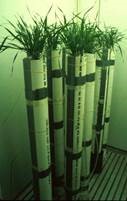The Pot Experiment – Is it Your Cup of Tea?
By Abraham Blum
Experiments performed with pot-grown plants are probably the most common in plant research. The need to perform “controlled” experiments often replaces observations on plants grown in their native environment by bringing plants for “closer” observation in the “controlled” laboratory. Plants are then grown in an artificial environment in various containers with various media and placed under growing conditions which can range from growth chambers and greenhouses to the laboratory window sill.
Remember, optimal conditions are a great equalizer while stress conditions is an aggressive divisor. In other words, small variations in growing conditions will amplify differences in plant growth when these conditions are below the optimum. This is one of the expressions of the “law of diminishing returns”. Hence, pot experiments under stress conditions are prone to amplified error variance and artifacts.
The following pointers bring to the attention of the beginner, especially with plant stress pot experiments, some of the more common problems and their remedies.
Size matters
Pot size has a huge effect on plant growth, especially where the root environment is under stress, such as water limitation. Water use from a pot depends on plant size and its leaf area. Larger plants use more water daily as compared with smaller ones. When pot water content is limited a large plant will show symptoms of wilting before the smaller plant does. There is no harm in this occurrence, unless the researcher fails to recognize it to be the result of the interaction between plant size and pot size and not a result of the experimental treatment.
 Here we come to a troubling issue for molecular biologists who try to assess the effect of a gene in a transgenic plant as compared with the wild type. In many cases the transgenic plant will also express a modification in plant size (leaf area), besides the specific effect of the gene. Then the question is how to account for the different leaf area in the two genotypes when stressed in a pot experiment? Qualified answers are rare. Sometimes you might find a suggestion in the literature to grow in one pot the two plants of the transgenic and the wild type together with the assumption that whatever is the rate of transpiration in any genotype, both will be exposed to the same soil water status in the pot. However even at the same soil water status in the common pot, the large plant will still express a lower leaf water status because of its greater demand for water (at any soil water status). You do not obtain the same plant water status in the two plants even if they are exposed to the same soil water status – as long as the two plants differ in leaf area.
Here we come to a troubling issue for molecular biologists who try to assess the effect of a gene in a transgenic plant as compared with the wild type. In many cases the transgenic plant will also express a modification in plant size (leaf area), besides the specific effect of the gene. Then the question is how to account for the different leaf area in the two genotypes when stressed in a pot experiment? Qualified answers are rare. Sometimes you might find a suggestion in the literature to grow in one pot the two plants of the transgenic and the wild type together with the assumption that whatever is the rate of transpiration in any genotype, both will be exposed to the same soil water status in the pot. However even at the same soil water status in the common pot, the large plant will still express a lower leaf water status because of its greater demand for water (at any soil water status). You do not obtain the same plant water status in the two plants even if they are exposed to the same soil water status – as long as the two plants differ in leaf area.
Another approach, untested yet, is to plant the two genotypes in pots on staggered planting dates so that among the different planting dates you can find plants of comparable size in both genotypes and use these pots for the dry-down experiment.
Often in cases of limited facility space, such as a growth chamber, the smallest pots possible are chosen so as to allow more pots and plants inside the chamber. The conventional wisdom is that if nutrients and water are supplied almost daily, root space is of no consequence. However, research results show that the physical constraint of roots in a small container can have a net negative effect on plant growth. This effect is the basis for the well recognized negative effect of hard soil and hard-pans on plant growth even when it is well supplied with water and nutrients. Certainly one may argue that all plants in the experiment are exposed to the same small pot constraints, but again there might be a treatment or a genotype interaction with this constraint, such as plants having a different root size. For example (and there are many more), genotypic rating of barley for response to Mn deficiency varied with pot size. Furthermore, plants in small pots will desiccate very fast when irrigation is terminated – which is in contrast to natural environments. Therefore, when root constraints in a limited pot volume might cause a serious bias or artifacts in the experiment, greater pot volume is essential. In experiments where freely growing roots were crucial, long PVC tubes were used to grow the plants (see photo).
See also : Pot size matters: a meta-analysis of the effects of rooting volume on plant growth
Media and press
Various potting media such as soil, all kind of ad-hoc mixtures and commercial potting mixtures serve as root media. The pros and cons of the different media used are tightly linked to the purpose of the experiment. For example, if one wishes to recover clean roots by washing them out of the pot, a potting mixture containing a lot of peat and other organic materials is a nuisance because these cling tightly to the roots. Commercial potting mixes tend to be coarse so as to optimize aeration and drainage. This would reduce the likelihood of water-logging but on the other hand potting mixtures might behave differently from soil in their water holding capacity and water release characteristics. In plant water-relations and drought stress experiments it is desirable to use media that are close to soil in their water relations characteristics. Chances for water-logging in soil-filled pots can be reduced if the pot is relatively tall, say >40 cm. On the other hand soil of high clay content should be avoided since it tends to shrink, crack and cause serious root damage upon drying in a pot.
Plant nutrients are a crucial factor in plan growth and the way these are served to a potted plant should be carefully considered in view of the experimental treatments. This is true for commercial mixtures which may not be designed for the special experiment you are to perform. Experiments with deficient nutrients or with toxic minerals require a special review which is beyond this discussion.
Whatever potting medium is used it must be absolutely free of any soil inhabiting plant parasitic factors such as root diseases or nematodes. Medium sterilization is a standard precaution. Where sterilization equipment is unavailable, soil solarization is also an effective method (http://www.agri.huji.ac.il/~katan).
However one precaution is common to all experiment and that is a standard routine for filling up the pots. Usually a technician or student is sent over to the shed with the instruction to fill up a number of pots for an experiment, which he might do by scooping the mixture into the pots. Much more consideration should be given by caring to achieve standard soil (mix) bulk density in all pots. This is important with the heavier mixtures which contain more soil or with the very light-organic mixtures which tend to be fluffy. Furthermore, bulk density should be high enough to avoid air pockets especially around the walls of the pot. These capture roots which tend to grow along a path of least resistance. It very common to find out that roots grow more around the wall of the pot, which may lead to an experimental artifact. Furthermore, with water deficit experiments when the mixture dries out it might shrink away from the wall and expose these roots to air. Dense mixtures (avoid clay) and higher bulk density in the pot should circumvent the problem.
The simplest way to standardize soil bulk density is by taking care that the potting mix is very homogenous and by filling the pot in a standard manner. Eliminating air pockets in the pot is not done by pressing the mix into the pot with your fingers. The best way is simply to pound the pot against the ground in a standard way in order to settle the mix in the pot. This, combined with filling a given weight of mix per pot is important.
Color discrimination
So you ordered 100 pots without any reference to their color and received some black and some white ones. Should you worry? Probably not – if you use them in a crowded growth chamber. However in a greenhouse exposed to sunlight color makes a huge difference. Black pots will heat up several degrees above white pots when exposed to direct sun for several hours. So if your supplies department will not return the black pots to the store, do not make a fuss! These people are edgy anyhow. Better paint them (I mean the black pots) in white to make them useful.
“We imposed drought stress…” you wrote in ‘Materials and Methods’?
Most pot experiments which address drought stress design a stress treatment by stopping irrigation and allowing soil to dry and plants to suffer. This is a legitimate protocol as long as the pot is not too small (see above) and plants do not wilt and desiccate too fast within a couple of days. We call this a “crash” or a “shock” treatment which rarely happens in nature or in the farmer’s field. Usually stress is progressing slowly and plants go through various steps of adjustment until they wilt. Therefore, drought stress in pots must proceed slowly, for at least a week until plants begin to express stress symptoms such as initial wilting at midday. The main control of this time duration is pot size relative to plant size.
Another approach is sometimes found in the literature. With this approach the researcher attempts to maintain a “fixed” level of drought stress in the pot. This is presumably done by calculating the water holding capacity of the pot and by maintaining less than that amount (say 50%). This is done by weighing the pot and replenishing the amount of water loss up to that deficient level (say 50% field capacity). This results in a frequent supply of small amounts of water to the surface of the soil of a droughted plant. Only the top soil of the pot exchange water with the environment and only that layer receives small amount of water. These plants are not “stressed” in the narrow sense since they undergo frequent stress-recovery cycles which are very complex physiologically and are quite different from a prolonged normal cycle of stress. This protocol might be correct mathematically but it is incorrect physiologically. We call it “the book-keeping method’.
Another option for applying drought stress which requires experience is performed when plants are grown in deep containers such as upright PVC tubes sealed-drained at the bottom (photo). Plants are established on a fully wet profile after which irrigation is stopped. Water is then supplied only from the bottom (the tube is set in a pail of water with a fixed water level). This simulates to some extent a crop grown on a deep water table with little or no rainfall. Here, the role of deep root growth becomes a major factor in plant adaptation to drought stress. With simple means (such as tube length or water table level) one can vary the depth of the water table between treatments or during the growing season.
Often soil moisture content in the pot is measured to assess extent of dryness. It is always more reliable and relevant to measure plant water status under the effect of soil water limitation rather than soil water status in itself. Measurement of soil moisture is an additional assessment of stress but not the main one. The plant is the indicator. When soil moisture is measured avoid one common error: do not use tensiometers. These were not designed to measure low soil water potentials common to real stress conditions. Avoid using all kinds of home-use probes and “water-sensors” sold in garden supply shops. Accurate methods applicable to pots range from the expensive TDR system to the cheap gravimetric measurements of soil samples.
Water-relations experiments often include pot weighing as a legitimate method of estimating transpiration. Remember that water is lost from pots not only via plant transpiration but also via soil surface evaporation. You can account for soil evaporation by using deep mulch, cover or by weighing a control pot without a plant. Carrying and lifting heavy pots for weighing is a job most of us dislike. Hence, Prior et al. (2006) offered a nice hydraulic pot lifting/weighing device that will be appreciated by your back. If you wish to simplify and economize you can think of modifying their design by using a simple hand-pulley to lift the pot, instead of hydraulics.
Location is everything
So your Department has a brand new greenhouse with tables all over to your heart content. Do not put your pot experiment anywhere. First look around for sources of gradients in light, wind or temperature inside the greenhouse. There may be a tall building nearby which might shade part the greenhouse in the morning or evening. The cooling system might have been set up so that it is cooler close by and warmer further away. Do not set your plants near the door where people go in and out all day long. Even in a perfect greenhouse, there can be a temperature gradient from the wall towards the center.
Once you identify a gradient, better get away from it. If that is not possible place your replications (blocks) downstream along the gradient so that the differential environment will be accounted for by the replicates. You might sometime think of an ingenious way to use the gradient as an experimental treatment, such as variable temperature. Perfectionists go by the book and rotate their pots inside the greenhouse so as to sample all environmental conditions within the greenhouse. This is often done by placing the pots on a trolley and moving and rotating the trolley about the greenhouse daily. Recent modern “high throughput” phenotyping installations put the pots on moving belts which is an ideal but a rather expensive solution.
Good luck with your work …………







